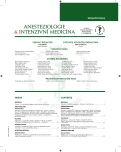Comparison of opioid and non-opioid analgesia after caesarean section under general anaesthesia: a prospective observational study
Authors:
Štourač Petr 1,3,6,8; Seidlová Dagmar 1,5,8; Bártíková Ivana 1; Kuchařová Eliška 4; Janků Petr 2; Křikava Ivo 1,3; Huser Martin 2; Wágnerová Kristýna 2; Haklová Olga 3; Hakl Lubomír 3; Štoudek Roman 1; Kosinová Martina 1,3; Schwarz Daniel 6; Zelinková Hana 6; Ševčík Pavel 3,7; Gál Roman 1
Authors‘ workplace:
Klinika anesteziologie, resuscitace a intenzivní medicíny, FN Brno a LF MU, Brno
1; Gynekologicko-porodnická klinika, FN Brno a LF MU, Brno
2; Oddělení léčby bolesti, FN Brno, Brno
3; Lékařská fakulta, Masarykova univerzita, Brno
4; II. Anesteziologicko-resuscitační oddělení, FN Brno, Brno
5; Institut biostatistiky a analýz, Masarykova univerzita, Brno
6; Anesteziologicko-resuscitační klinika, FN Ostrava a LF OU, Ostrava
7; Expertní skupina pro porodnickou anestezii a analgezii při ČSARIM
8
Published in:
Anest. intenziv. Med., 25, 2014, č. 1, s. 8-16
Category:
Anaesthesiology - Original Paper
Overview
Objective:
The aim of the prospective observational study was to compare the efficacy of opioid vs. non-opioid analgesia in postcaesarean pain management.
Design:
Prospective observational study.
Setting:
University Hospital.
Materials and methods:
In the Non-opioid group (NO) we used a combination of regular paracetamol 1000 mg IV or PO and diclofenac 100 mg PR or IM. In the Opioid group (OP) we used piritramide 3 mg per hour IV continuously. Additional metamizole 2.5g IV was administered as rescue analgesic in both groups. We recorded the Visual Analogue Scale (VAS), Additional Analgesic Requests (AAR) and complications during the postcaesarean period. We compared the VAS and AAR scores in both groups in the first 24 hours after caesarean section (CS).
Results:
With the Ethics Committee Approval, we enrolled 160 patients (NO, N=120; OP, N=40) after CS under general anesthesia in the period of May 2009 – April 2010. The median VAS score in the first hour after CS was 3.5 in both groups (p=0.553). There were statistically significant differences in the VAS and AAR in the 1st and 24th hour after CS (p < 0.001). No serious complications were recorded.
Conclusion:
We found sufficient analgesic effect (VAS under 4) in both study groups with better effect of the opioid analgesics in the first postoperative day.
Keywords:
acute pain service – pain management – postoperative analgesia – caesarean section – opioids – non-opioids – obstetrics –general anaesthesia
Sources
1. Mardešićová, N., Velebil, P. Epidemiologie císařských řezů. Postgraduální medicína, 2010, 2, p. 171–174.
2. Pan, P. H. Post cesarean delivery pain management: Multimodal approach. Int. J. Obstet. Anesth., 2006, 15, p. 185–188.
3. Štourač, P. Obstetric Anaesthesia and Analgesia Month Attributes – reálná zpráva o anesteziologické praxi na českých porodních odděleních. Anest. Intenziv. Med., 2013, 24, 2, s. 81–82.
4. Betran, A. P., Merialdi, M., Lauer, J. A. et al. Rates of caesarean section: Analysis of global, regional and national estimates. Paediatr. Perinat. Epidemiol., 2007, 21, p. 98–113.
5. Villar, J., Valladares, E., Wojdyla, D., Zavaleta, N., Carroli, G., Velazco, A. et al. Caesarean delivery rates and pregnancy outcomes: The 2005 WHO global survey on maternal and perinatal health in Latin America. Lancet, 2006, 367, p. 1819–1829.
6. McGlennan, A., Mustafa, A. General anaesthesia for Caesarean section. Contin. Educ. Anaesth. Crit. Care Pain, 2009, 9, 5, p. 148–151.
7. Dolin, S. J., Cashman, J. N., Bland, J. M. Effectiveness of acute postoperative pain management. I. Evidence from published data. Br. J. Anaesth., 2002, 89, p. 409–423.
8. Royakers, A. A. N. M., Willigers, H., van der Ven, A. J. et al. Catheter-related epidural abscesses—don’t wait for neurological deficits. Acta Anaesthesiol. Scand., 2002, 46, p. 611–615.
9. Gadsden, J., Hart, S., Santos, A. C. Post-cesarean delivery analgesia. Anesth. Analg., 2005, 101, p. 62–69.
10. Mitra, S., Khandelwal, P., Sehgal, A. Diclofenac-tramadol vs. diclofenac-acetaminophen combinations for pain relief after caesarean section. Acta Anaesthesiol. Scand., 2012, 56, 6, p. 706–711.
11. Miranda, H. F., Puig, M. M., Prieto, J. C., Pinardi, G. Synergism between paracetamol and nonsteroidal anti-inflammatory drugs in experimental acute pain. Pain, 2006, 121, 1–2, p. 22–28.
12. Samina, I., Khurram, S., Faraz, S. Observational study to assess the effectiveness of postoperative pain management of patients undergoing elective cesarean section. J. Anaesthesiol. Clin. Pharmacol., 2012, 28, 1, p. 36–40.
13. Bush, D., Lyons, G., Macdonald, R. Diclofenac for analgesic after caesarean section. Anaesthesia, 1992, 47, p. 1075–1077.
14. Ševčík, P., Málek, J., Bejšovec, D., Gabrhelík, T., Křikava, I., Lejčko, J., Mach, D., Mixa, V., Vojtíšková, M., Fricová, J. Léčba akutní pooperační bolesti. Anest. Intenziv. Med., 2008, 19, 3, s. 162–169.
15. Steffen, P., Krinn, E., Möller, A., Seeling, W., Rockemann, M. G.Metamizol and diclofenac profoundly reduce opioid consumption after minor trauma surgery. Acute Pain, 2002, 4, 2, p. 71–75.
16. McDonnell, N. J., Keating, M. L., Muchatuta, N. A., Pavy, T. J., Paech, M. J. Analgesia after caesarean delivery. Anaesth. Intensive Care, 2009, 37, p. 539–551.
17. The American Academy of Pediatrics Committee on Drugs The transfer of drugs and other chemicals into human milk. Pediatrics, 2001, 108, p. 776–785.
18. McWhorter, J., Carlan, S. J., O‘Leary, J. D. et al. Rofecoxib versus magnesium sulfate to arrest preterm labor: randomized trial. Obstet. Gynecol., 2004, 103, p. 923–930.
Labels
Anaesthesiology, Resuscitation and Inten Intensive Care MedicineArticle was published in
Anaesthesiology and Intensive Care Medicine

2014 Issue 1
Most read in this issue
- Myasthenia gravis and anaesthesia – a new and safer approach
-
Current Practice in Obstetric Anaesthesia.
Part III. Regional anaesthesia for caesarean section -
Karl Koller – the discoverer of the local anaestheticproperties of cocain, was born in Susice!
A short history of local anaesthetics - Focused on pre-renal acute kidney injury – has the time come to rewrite the textbooks?
